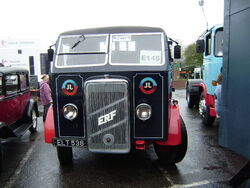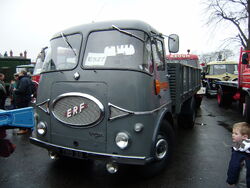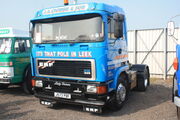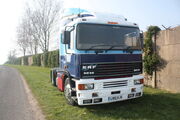 | |
| Fate | Taken over/Closed |
|---|---|
| Successor | MAN AG |
| Founded | 1933 |
| Defunct | 2007 |
| Headquarters | Sandbach, Cheshire |
| Key people | Edwin Richard Foden (Founder) |
| Industry | Truck |
| Parent | MAN AG |

First ERF Built in 1933 now in the BCVM in Leyland, Lancashire

An early ERF at Sandbach Transport Festival 2008

An early ERF at Sandbach Transport Festival 2008

Line up of 3 ages of ERF at Sandbach Transport Festival 2008

A 1990s ERF 4x2 tractor unit
A Modern ERF tractor unit and semilow-loader trailer giving a lift to an older Rigid chassis version from the 1970s
ERF was a British truck manufacturer. Established in 1933 by Edwin Richard Foden, its factory in Sandbach, Cheshire was closed in 2002, and finished as a brand by owner MAN AG in 2007.
History
Established in 1933 by Edwin Richard Foden, who had left Foden - the company founded by his father - because he believed the future lay in diesel rather than steam power and based in Sandbach in Cheshire, the company made their own chassis and cab with engines from Gardner, Cummins, Perkins, Detroit Diesel and Caterpillar.
ERFs used to be marketed under the Western Star badge in some countries such as Australia. It built a specialist fire engine chassis, with a body built on by in-house company JH Jennings, later Cheshire Fire Engineering. However, when recession came in the early 1980's and production fell from a total output of 4,000 chassis per annum, CFE was sold to management to eventually become Saxon Sanbec.
The company was bought by Canadian truck maker Western Star in 1996. However, after PACCAR's purchase of both DAF Trucks and Leyland Trucks increased competitive pressure, and Western Star was approached by Freightliner corporation, the decision was made to sell ERF.
Purchase by MAN
In 2000, ERF became part of MAN. MAN bought the company on the understanding that ERF was profitable, but it was found that its Financial Controller had for years been syphoning monies from the company, and resultantly MAN sued Western Star successfully in the British courts. Freightliner tried to sue Western Star and ERF's former auditors, but failed on technical grounds of corporate negligence [1]
Model Range
The First Models
B 1939 range had grown to include 3 + 4 axle rigid models and a twin axle tractor unit. They also built a twin steer 6 wheeler (3 axle). During the war some were fitted with AEC engines in place of the Gardners.
The Model V
The new range designated the model V was introduced after the war in 1948. In 1951 a steel cab was introduced for export markets built by Willenhall Motor Radiator Co..
The KV range
The KV with a modern oval grill and curved split screen was introduced in 1954.
The LV range
The LV was introduced in 1962, fited with fail safe spring brakes, (a first for a British manufacturer).
The A series
A New designer in 1972 saw the A series arrive with modular design for mass production. The 34-ton gross A series tractor unit was offered with either a 6-cylinder Cummins or 6 or 8-cylinder Gardner engine's. A 38-ton European version was built with a Motor Panels tilting cab.
The B series
The B series was introduced in 1974 with a SP (steel/plastic)cab. It was offered with Gardner, Cummins and Rolls Royce power units. This was the first production ERF to have a tilt cab (for easy access to the engine) It was available in the normal "day cab" configuration and optional "sleeper cab" a very new idea for british trucks in 1974. There was also a smaller M series rigid with the walkthrough cab design (this looked much like the larger B series but had the headlamps in the bumper as opposed to just above) This was lighter duty vehicle. Some were fitted with the Dorman V8 diesel engine, although this was a rare option.
The C series
The C series was launched in the early 1980's, it was pretty much a revised B series with simular engine choices. The C series was also known as the C40 and the CP series (CP = Cummins Power) During production of the C series Gardner diesels ceased production and Cummins became the main choice for operators. ERF chose to jump D series due to the popular Ford truck of the 60's and 70's. hence the E series was the next generation.
The E series

A Restored ERF E10 325 tractor unit presented at the Donington Park CV show in 2009

A ERF E10 325 converted to a Showmans ballasted tractor running the fairground at Boroughbridge Classic Vehicle show 2009
The E series was radical advance over the B and C series, with the introduction of a wrap-a-round dash board as most modern trucks have today. The day cab was still an option early on but the "rest cab" was also available and became the option for most day use vehicles. The sleeper cab was much more driver friendly than previous models. The E series was available with Cummins diesels and Rolls Royce diesels (who were later owned by Perkins) The ERF logo was relocated to the upper left of the grill and a badge denoting engine size was placed on the lower right of the grill. Models being E10 E14 E12 E9 etc E meaning E series + number denoting the engine size. This idea stayed with the EC series and the New style logo stayed until the last ERF rolled out in 2007 (albeit a rebadged MAN from Austria)
The EC series

A ERF EC14 6x2 at Donnington Park CV show in 2009

A ERF E14 rigid and drawbar trailer unit equipped as a Car Transporter unit in the auction at Donnington Park CV show in 2009
the EC was launched in 1993, it was the last true ERF design prior to being taken over by Western Star, who then did nothing really but own the company. ERF was then sold to MAN of Germany in 2000. This is when EC series production ceased and the company relocated to Middlewich Cheshire.
Final model range
ERF's final model range consisted of the ECT, ECM, ECL and ECX built on MAN's production line in Nuremberg (for heavy trucks), and a plant in Middlewich for light trucks (positioned to win a contract from the Ministry of Defence for 8,000 new British Army trucks).
All the recent ERF trucks were based on MAN's existing products, the only difference being that the ERF model came with the option of specifying use of Cummins ISMe power plant as an alternate to MAN's own D20 common rail power-plant. The Middlewich factory was closed by MAN in 2002, with production of the ECT, ECM and ECL units moving to Salzburg, Austria where they are built on the same facilities as their identical MAN counterparts.
In the light of Cummins' intransigence on upgrading the ISMe engine to comply with the Euro4 emission regulations, MAN initially took the decision to replace it completely with the new series of MAN D20 engines.[3] With ERF badging only used for the British market, MAN decided to cease the supply of ERF badged trucks from July 2007.
Preserved Machines

An unusual 'Chinese six' ERF recovery wagon (Wrecker) at Donnington Park CV show in 2009

A Rolls Royce engined ERF at Boroughbridge Classic Vehicle show in 2009
Examples of ERF's early trucks can be found a several truck shows and at Commercial vehicle gatherings and at the steam and tractor rallies which incorporate a commercial vehicle section.
- Events with a number of commercial vehicles at them include
- Belvoir Castle show
- Boroughbridge Classic Vehicle show
- Cromford Steam Rally
- Donnington Park CV show
- Driffield Steam Rally
- Great Dorset Steam Fair
- Holcot Steam Rally
- Kettering Steam Rally
- Lincoln Steam Rally
- Llandudno Transport Festival
- Rushton Transport Cavalcade
- Sandbach Transport Festival
Gallery
See also
- Collector & preservation related
- Shows and Meets add any events you know of to the list
- Clubs Listing - Add your club or find out about others for any make or machine type
- Collections - add any collectors with a lists of there machines (these are private collections that appear at shows or have charity / club opendays)
- Museums List - museums with a tractor or steam or transport collection
References
- Article based on the Wikipedia one, with expanded history and model list being added.
- ↑ Healys Solicitors - London - Brighton - Articles
- ↑ The Word Encyclopedia of Trucks, by Peter J. Davis, pub by select editions, ISBN 1-84309-201-8
- ↑ Big Lorry Blog : Friday, December 02, 2005 - Posts
External links
| This page uses some content from Wikipedia. The original article was at ERF. The list of authors can be seen in the page history. As with Tractor & Construction Plant Wiki, the text of Wikipedia is available under the Creative Commons by Attribution License and/or GNU Free Documentation License. Please check page history for when the original article was copied to Wikia |